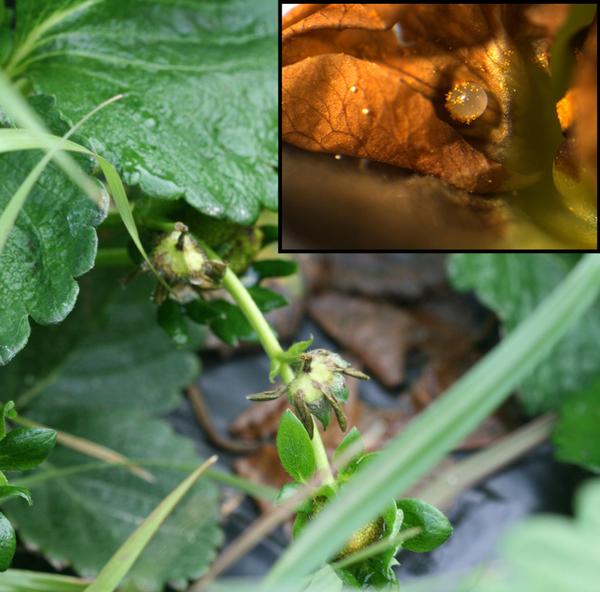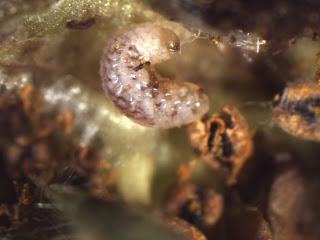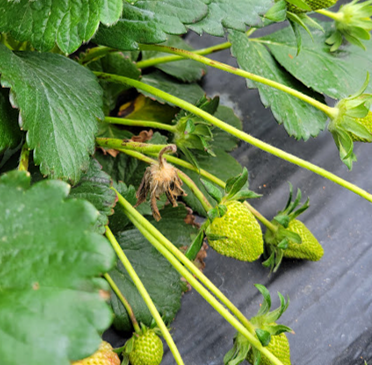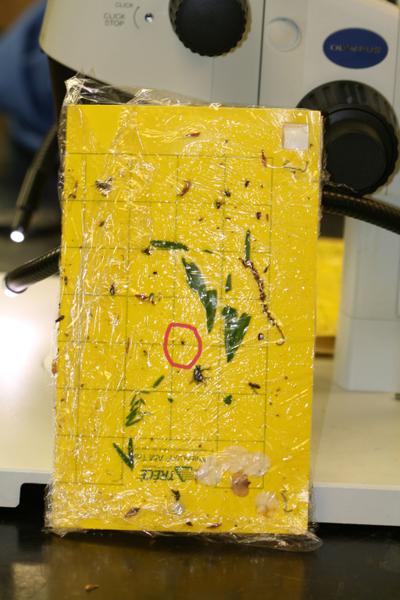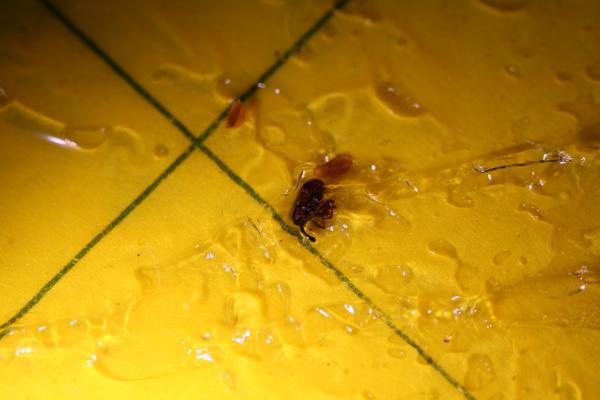Biology
Strawberry clipper weevils (Anthanomus signatus) are small (0.25 inches long), brown beetles with the characteristic weevil "snout." Strawberry clippers have one generation per year and overwintered adult beetles typically become active in spring, mid to late April in North Carolina. Known hosts include strawberry, blackberry, raspberry, dewberry, and red bud. Female beetles lay a single egg in developing flower buds of host plants and larvae develop and feed internally. Following pupation within damaged buds, new adult beetles emerge and enter a summer estivation period and winter diapause in sheltered areas surrounding plantings.
Damage in Strawberry
Following egg laying female beetles chew through the pedicel, which supports the flower bud. This causes the bud to dry while barely hanging in the plant or drop completely from the plant. The larvae develop in the dropped flower bud over the course of 3 to 4 weeks. Adults emerge in mid summer, briefly feed on pollen and then overwinter. There is only one annual generation of strawberry clipper. Beetles overwinter in wooded areas, so fields located near the woods or rows closest to the woods often experience the greatest clipper injury.
While bud loss is often quite concerning to strawberry growers, research conducted in New York (perennial production) and observations in North Carolina (annual production) suggests that plants can compensate in fruit size and fruiting timing for clipper damage to a significant degree. Therefore, it is unclear how important it is to prevent strawberry clipper damage.
Sampling and Thresholds
Observing clipped buds is the only recommended form of sampling for strawberry clipper weevils. While there are thresholds currently recommended by entomologists in Virginia (0.6 clipped buds per ft) and New York (2 clipped buds per meter), observations have also suggested that strawberry plants can compensate for significant levels of bud loss.
Research on the impact of clipper in matted row strawberries in New York (English-Loeb, et al.1999, subscription needed to view full article) found that all strawberry varieties tested compensated well for early season clipper damage, specifically damage to primary and secondary buds. Only damage in later season (tertiary) buds resulted in a significant yield loss because the the plant was not able to mature additional fruit. A closely related species has been studied in Europe in perennial strawberry plantings (Aasen and Trandem 2006, subscription may be needed to view full article), where yield does appear to be improved when insecticides targeted to clippers are applied.
Essentially no work on the impact of strawberry clipper weevils in annual plasticulture production has been conducted, and further work is needed on compensation in our key strawberry varieties as well as strawberry clipper biology in North Carolina.
Management Options
Conventional insecticides
Most insecticides recommended for strawberry clipper weevils are broad spectrum materials, and extreme caution should be used when making applications of these materials during bloom, when clippers are active. No pesticide should be applied when bees are foraging, during the day time. Necessary applications should be made in the evening, after bee foraging has ceased. Refer to the North Carolina Agricultural Chemicals Manual for materials recommended for use against strawbery clipper weevils in North Carolina and pesticide toxicity information for honeybees. The Southern Region Small Fruit Consortium Strawberry IPM Guide includes regional recommendations.
Organic insecticides
No organically acceptable insecticides have been demonstrated effective against strawberry clipper weevils.
Cultural control
Plant compensation may offset strawberry clipper damage.
More Information
Strawberry clipper posts - Entomology Portal
Strawberry clipper posts - NC Small Fruit & Specialty Crop Entomology
Publication date: June 25, 2014
Reviewed/Revised: Dec. 29, 2024
N.C. Cooperative Extension prohibits discrimination and harassment regardless of age, color, disability, family and marital status, gender identity, national origin, political beliefs, race, religion, sex (including pregnancy), sexual orientation and veteran status.

